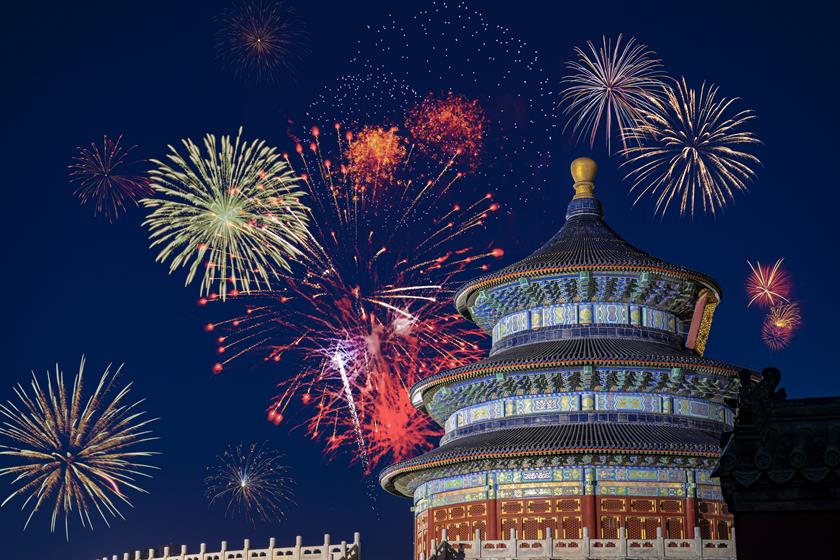Chinese Name: 天坛 Pronunciation: tiān tán
Recommended Time for Visit: 1-2 Hours
Building Time: 1420
Occupied Area: About 2.73 million square meters
Address: East side of Yongding Gate Inner St, Dongcheng District, Beijing
Popular Activities: Local people doing morning exercises and practice Tai Chi.
Best Visiting Season: Spring and Autumn (March to May, September to November)
Building Function: Emperors of the Ming and Qing dynasties (from 1420 to 1900) worshiped the god of heaven and prayed for good harvests.
|
Tickets
|
Peak Season
(April 1st to October 31st) |
Low Season
(November 1st to March 31st) |
| Admission Fee | 15 yuan | 10 yuan |
| Joint Ticket (including the admission fee, Hall of Prayers for Good Harvests, Circular Mound Altar and Echo Wall) |
34 yuan | 28 yuan |
| Joint Ticket (Hall of Prayer for Good Harvests, Circular Mound Altar and Echo Wall) |
20 yuan | |
| Divine Music Administration | 10 yuan | |
| North Holy Kitchen, North Sacrifice Pavilion and the Abstinence Hall |
Free, but please change the ticket at the corresponding ticket counter with ID card | |
|
Park Gate
|
Peak Season
(April 1st to October 31st) |
Low Season
(November 1st to March 31st) |
| Opening Hours | 6:00-21:00 | 6:30-21:00 |
| Ticket Office Opening Hours | 6:00-20:00 | 6:30-20:00 |
| Joint Ticket Office Opening Hours | 8:00-16:00 | 8:00-15:30 |
| Closing Time | 22:00 | |
|
Attractions
(Including Hall of Prayer for Good Harvests, Circular Mound Altar and Echo Wall) |
Peak Season
(April 1st to October 31st) |
Low Season
(November 1st to March 31st) |
| Opening Hours | 8:00-17:30 | 8:00-17:00 |
| Ticket Office Opening Hours | 8:00-16:30 | 8:00-16:00 |
| North Holy Kitchen, North Sacrifice Pavilion and the Abstinence Hall |
From Tuesday to Sunday: 9:00-12:00 13:00-16:00 |
|
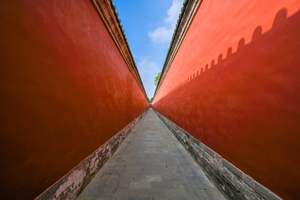
Located in the south of Beijing, the Temple of Heaven was the place where emperors of the Ming and Qing Dynasties offered sacrifices to the God of heaven and earth and prayed for grain harvest. With the rigorous layout, unique structure and magnificent decoration, it is considered to be one of the most exquisite and beautiful ancient architectural complexes in China. It is not only a pearl in Chinese ancient architecture but also a treasure in the history of world architecture.
The Temple of Heaven is 1700 meters long and 1600 meters wide, with a total area of 2.73 million square meters. Originally built in 1420 in Ming Dynasty, it was rebuilt during the reign of Emperor Qianlong and Guangxu of the Qing Dynasty. The temple of Heaven, the general name of the Circular Mound Altar and Grain Praying Altar, is divided into two parts: the outer altar and the inner altar. And the main buildings are mainly lie in the latter part. The whole altar is round in the north and square in the south, implying the long-standing concept of “Round Sky and Square Earth” in China.
On the same axis, the Circular Mound Altar and the Grain Praying Avatar are separated by walls, one in the north and the other in the south. Buildings worth visiting in Circular Mound Altar are Circular Mound, the Imperial Vault of Heaven, Abstinence Hall, Divine Music Administration and so on. And the most popular buildings in Grain Praying Altar are the Hall of Prayer for Good Harvest, the Hall of Imperial Zenith, etc.
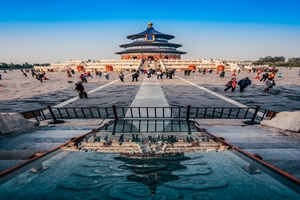
In 1530, Emperor Jiajing of the Ming dynasty, after listening to his ministers' advice, decided to separate the sacrifice rite into two altars. Therefore, He ordered to build the Circular Mound Altar in the south of the Great Hall of Sacrifice and the Fangze Altar outside the Anding gate of the northern city.
In 1534, the 13th year of the reign of Emperor of Jiajing of the Ming dynasty, the Circular Mound Altar was renamed as Temple of Heaven (Tiantan and Fangze Altar as Temple of Earth (Ditan). Reduced into a dilapidated place, the Great Hall of Sacrifice was then changed into an altar for praying the grain.
In 1900, as headquarters of the Eight-Power Allied Forces, the Temple of Heaven was deprived of masses of cultural treasures and sacrificial utensils. And, at the same time, the numbers of buildings and trees were heavily destroyed.
After the founding of the People's Republic of China in 1949, the government invested a huge amount of money in the protection and maintenance of the cultural relics and historic sites in the Temple of Heaven.
In 1961, it was listed into the National Priority Cultural Relic Protection Sites.
In 1998, it was recognized as "World Cultural Heritage" by UNESCO.
On May 8, 2007, the temple of Heaven Park was officially approved as a national 5A tourist attraction by the National Tourism Administration.
On July 12, 2018, Li Gao, director of the Temple of Heaven Park, introduced that the park will increase the green area by nearly 20000 square meters and expand the open area for tourists by 2.24 hectares.
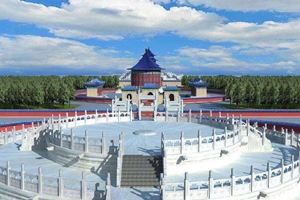
Built-in 1530, the 9th year of the reign of Emperor Jiajing in the Ming Dynasty, the Circular Mound Altar is the place where sacrificial rite is held in the winter solstice. It mainly consists of Round Hill, Imperial Vault of Heaven and its side halls and annexes such as Dressing Platform. It was a three-layer blue glazed round altar in Ming Dynasty and had been further enlarged in 1749, the 14th year of the reign of Emperor Qianlong in the Qing Dynasty. The blue glasses were replaced with a celadon platform and white marble columns.
The circular mound has three layers, 5.17 meters in height, 54.92 meters in diameter in the lower layer and 23.65 meters in the upper layer. Each layer has nine steps on four sides. In the center of the upper layer is a pebble paved with nine fan-shaped stones and extended outward in turn with stones in multiple of nine, symbolizing the number that represents heaven. Located in the southeast of the outer part of the Circular Mound Altar, the Firewood Stove is built of green glazed bricks and is used to burn the sacrificial objects to the heaven and earth during the winter solstice ceremony.
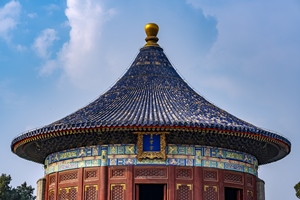
Located on the north side of the Circular Mound Altar, it is a place set for worshiping the spirit tablets with three glazed doors in the south. The imperial vault is supported by 16 pillars, eight eaves pillars in the outer layer and eight gold pillars in the middle. The span of its caisson is unparalleled in Chinese ancient architecture. Counting from the north, the first three stone slabs are called Three Echo Stone where can hear the echo when clapping hands.
The Echo Wall is the wall of the Imperial Vault of Heaven. The wall is 3.72 meters high, 0.9 meters thick, 61.5 meters in diameter, and 193.2 meters in circumference. The walls are made of polished bricks, and the walls are covered with blue glazed tiles. The arc of the wall is very regular, and the wall is extremely smooth and tidy, so the reflection of sound waves is very regular.
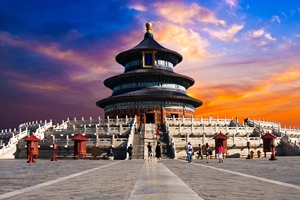
Just as the name indicated, this place was used to pray for a good harvest in Qing and Ming Dynasty. As the main building in the Temple of Heaven, the hall is supported by 28 large silkwood pillars with distinctive features and significance.
The four "Dragon Well Pillars (Longjingzhu)" in the middle of the hall symbolize the spring, summer, autumn, winter, four seasons of the year. The twelve large pillars in the middle layer, slightly thinner than the former, are named golden pillars, standing for the 12 months of the year. The outer 12 pillars are called eaves column, symbolizing the 12 hours of a day. And the total 24 pillars in the middle and outer layer respectively represent 24 solar terms. (days marking the 24 divisions of the solar year in the traditional Chinese calendar)
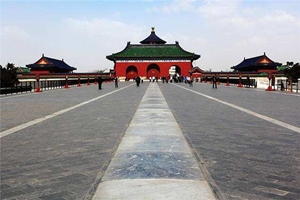
Danbi Bridge, 360 meters long, is a road 4 meters above the ground connecting the Circular Mound Altar and Grain Praying Altar. Under the middle of the avenue, there is an east-west tunnel enabling it to be a bridge, the oldest overpass in the ancient capital of Beijing. The bridge deck is 30 meters wide, with the middle “divine road” for the lord of heaven, the east “royal road” for the emperors, the west “Wang road” for ministers, which distinctly displays the strict hierarchy in ancient China. Stepping on it, visitors may feel like ascending to heaven.
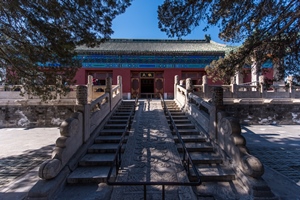
Located in the southwest corner of the altar of praying for a good harvest, Abstinence Hall is the place where the emperor fasted before the ceremony of offering sacrifices to heaven and earth. The palace is built with Beamless Hall, Sleeping Chambers, Bell Tower, Patrol Corridor, which are all constructed by green glazed tiles and specially used for etiquette, residence, service and security.
With a rigorous layout and elegant environment, it is the representative work of ancient Chinese architecture for fasting. As the main hall in it, the Beamless Hall, with simple decoration inside, is the place where the emperor fasts during the daytime. The plaque hung there written by Emperor Qianlong in the Qing Dynasty expresses the emperor's piety to heaven.
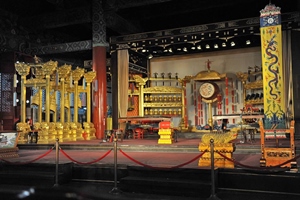
At the west side of the Temple of Heaven, it is the place for rites and music exercises in the Ming and Qing Dynasties and is known as the highest institution of rites and music at that time. The Divine Music Administration, with an area of 600 square meters, was first established in 1420, the 18th year reign of Yongle, with the name of Divine Music Temple where boasts numerous palaces, tea houses, herbal medicine shops, etc. Then it was finally named Divine Music Administration in 1754, the 19th year of the reign of Emperor Qianlong.
Now it has been opened up as the "Zhonghe Shao Music" exhibition area, holding ancient sacrificial music and dance performances, and also as the main exhibition hall of Zhonghe Shao Music instrument bell and chime stone.
a. Enter from South Gate of the Park→Circular Mound Altar→Echo Wall→the Nine Dragon Cypress→Danbi Bridge→Hall of Prayer for Good Harvests→Exit from the North Gate.
b. Enter from North Gate of the Park → Hall of Prayer for Good Harvests →Danbi Bridge →the Nine Dragon Cypress→ Echo Wall →Circular Mound Altar→ Exit from the South Gate.
c. Enter from East Gate of the Park→Long Corridor→Hall of Prayer for Good Harvests→Danbi Bridge→Echo Wall→Circular Mound Altar→Exit from the South Gate.
d. Enter from West Gate of the Park→Abstinence Hall→Divine Music Administration→Exit from the West gate.
East Gate: Take bus 6, 34, 35, 36, 39, 41, 43, 60, 72, 116, 128, 525, 599, or 684 and get off at Fahua Temple Station; No. 54, 957, 958, get off at Tiantan Stadium Station.
West Gate: Take bus 2, 20, 36, 53, 71, 72, 90, 93, 120, 622, and get off at the West Gate of Temple of Heaven.
South Gate: Take bus 36, 53, 62, 122, 525, 958, and get off at the South Gate of Temple of Heaven.
North Gate: Take bus 6, 34, 35, 36, 72, 106, 110 and get off at the North Gate of Temple of Heaven.
By Subway
Take Metro Line 5 and get off at the East Gate of Temple of Heaven Station and exit A.
Take Metro Line 8, get off at Tianqiao Station, and exit C.
By Taxi
Chinese: 请带我去天坛。English: Please take me to the Temple of Heaven.
Chinese: 请带我去天坛的东门。English: Please take me to the East Gate of the Temple of Heaven.
Chinese: 请带我去天坛的北门。English: Please take me to the North Gate of the Temple of Heaven.
If you go to the Temple of Heaven from the center of Beijing (Tiananmen Square), It takes about 15 minutes (20 yuan).
If you go to the Temple of Heaven from the Beijing International airport, it takes about 40 minutes (100 yuan).
If you go to the Temple of Heaven from the Beijing Daxing International airport, it takes about 55 minutes (150 yuan).
If you go to the Temple of Heaven from the Beijing West Train Station, it takes about 25 minutes (40 yuan).
